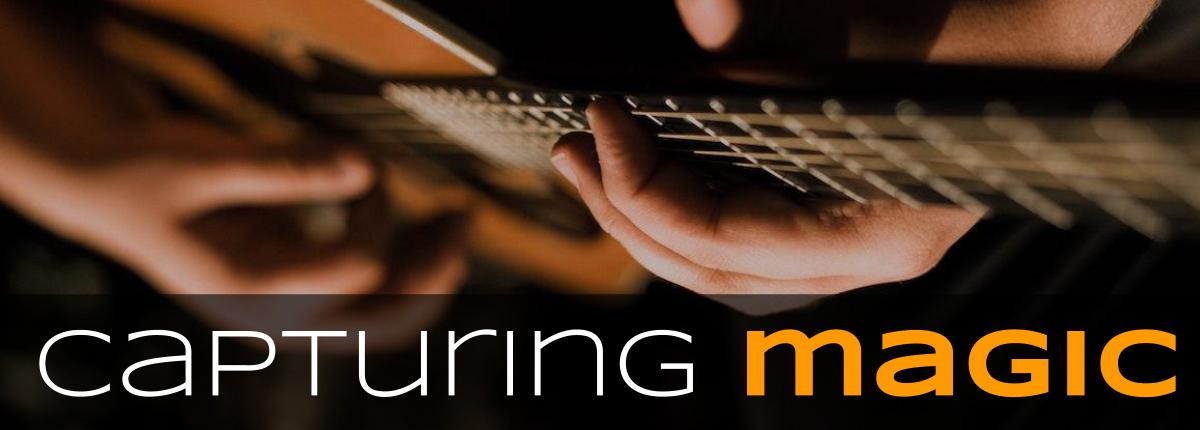
By Matt Gose
Posted 05/17/2022
Is there anything more intimate and moving than a live acoustic set? No frills. No gimmicks. Just pure musicianship and human connection. Magic!
While no recording can ever truly embody the full live acoustic experience, there are a few tried and true techniques from seasoned artists that can, at the very least, help capture those mystifying elements.
Here, we’ll explore a few techniques and tools you can use to beef up the quality of your live acoustic performances.
Small Budget, Big Creativity
Recording the beautiful simplicity of a live acoustic set can also be simple and relatively inexpensive. If budget is a primary concern, consider getting your feet wet with a single, simple field recorder.
Options such as the TASCAM DR-40x, the Zoom H4n Pro, and the Sony Linear PCM-D50 have long been utilized by industry pros, including the team behind NPR’s renowned Tiny Desk Concerts. These handheld tools feature high-sensitivity stereo condenser mics and often include phantom power and XLR inputs that can clearly capture the sound of your performance as well as the ambiance of the room.
This route does work best in quieter settings, like a room or a coffee house gig. For best results, you’ll need to recruit a friend to either sit or stand a few feet away from the stage, as close to the center as possible. If you can, try to do a practice run during your sound check to make sure the levels are balanced.
While this approach leaves no real options for mixing and leveling different instruments, it is a great starting place.
A Step Above Basic
Computer/ Audio Interface
For a slightly more professional live recording, you will either need to pony up a bit more budget or recruit someone who has access to a computer and an audio interface. Even with these tools, there is a wide array of options at different price points.
Even with a basic DAW and a two-channel interface, you can get a more nuanced and controllable live recording.
DI Box
When artists perform, they want to be free to move and groove as they please. While visually compelling, this can be an audio nightmare.
The solution? Direct boxes.
Ideally, this won’t be your only signal for acoustic instruments — if the instrument has a line out, USE IT. This gives you a clean, consistent signal to build off of, or solely rely on if all else fails.
If you’re recording other instruments such as bass, DI boxes can help manage bleedover. While signal bleeding is impossible to avoid entirely, the more you can isolate other instruments, the better.
Condenser Mic
Similar in principle to the field recorder, a solid condenser mic can pick up all the color and intricacies of a live performance. With a mic, you can get much closer to the performer, reducing interference from the audience or any other instruments.
Even with just one mic, you can adequately record guitar and vocal from a single performer. For best results, position the mic about halfway between the singer’s soundhole and the guitar’s soundhole. Then, line the mic up with the guitar’s twelfth fret. You can then inch the mic slightly closer to the guitar’s soundhole to pick up more of the body resonance. Be careful, though, to go no more than halfway between the soundhole and the twelfth fret.
The mic should be about six inches away from the performer, and the gain should be adjusted to receive the signal without clipping. Adjust as needed to find the right level of performer and ambiance.
Obviously, with two mics you can designate one for vocals and one solely for the guitar. Bear in mind, though, the positioning in relation to the guitar, as already mentioned.
Read the Room
Finally, if you have the available inputs, consider micing the room. Engineers like Audiotree’s Rick Fritz and Patrick Dewitte recommend using one or two small-diaphragm cardioid condensers spaced away from the band, in order to capture some of the natural reverb and ambiance of the performance space. Obviously, this works best with indoor performances, but can also help layer in some of the natural sounds of any live performance.
How far to space the mics depends on both the size of the room and the desired outcome. Place the mics five to six feet away from the performer to create a smaller room feel, or go for a longer distance to capture the vastness of the space. Experiment with different options to see what works best.
Feel Alive
The most important thing to remember is that the goal is to authentically document an actual, human performance. Exploring different options and using what you have on hand to best preserve the magic and unpredictability of a live performance is really what it’s all about. The tools are only part of the equation. The creativity of the engineer, and the quality and charisma of the performer ultimately make the magic happen.
